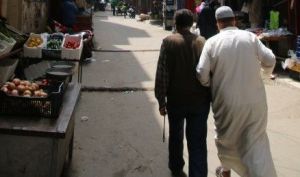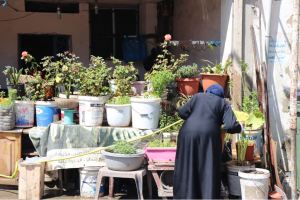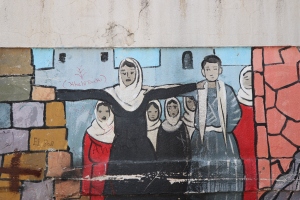How can historical manuscripts act as a ‘corrective narrative’ to dominant discourse from the ‘global North’? This blog post by Sumaira Nawaz examines the role and influence of South-South relations on the Turkish element of the travelogue of Indian intellectual, literary critic, poet and educationist, Maulana Shibli Numani. Numani’s travelogue, Safarnama-e Rum-o Misr-o Sham, was written while he travelled through the Ottoman Empire and Egypt, and it arose from the author’s acknowledgement that there was an urgent need to correct the biased nature of images of Muslims and Muslim literature outside India. Indeed, Nawaz argues that Numani’s travelogue was a “literary, pedagogical and ‘corrective’ historical narrative”, demonstrating the roles that have long-been played by diverse actors from the ‘South’ (or ‘East’) in challenging and resisting dominant narratives produced in the so-called global North. In this respect the blog contributes to the Southern Responses to Displacement approach and aims by centralizing perspectives, conceptualizations and narratives from the ‘global South.’
In her post, Nawaz first introduces the geographic, relational and historical context influencing Urdu literary movements during the nineteenth century, noting the ‘movement of intellectuals and reformers within the East…without drawing on European ‘centres’ like London, Paris or Rome.’ Using the examples of Turkey and its educational reforms, Nawaz then describes how Numani critiques Indian Muslim education systems, arguing that the modernization of Indian education and other systems should draw on examples of Muslim communities globally, rather than on Western ideas of modernity. Numani also highlights how Europe contributed to hindering contacts between Indian and Turkish Muslims, thus limiting the ability of reformers to draw on these examples. Inter alia, the post demonstrates the importance of developing historically and geographically-situated analyses which critically trace the implications of actual and potential connections between different parts of what is now often conceptualized as ‘the global South’.
This blog was posted on 4th July 2019
If you find this piece of interest please see our Thinking through the Global South series, and our recommended reading at the end of this post.
The Ottoman Empire in Indian Literary Imagination: Charting Shibli Numani’s Journey into Turkey Second Review
By Sumaira Nawaz
This blog focuses on the Turkish element of a travelogue titled Safarnama-e Rum-o Misr-o Sham, written by Indian intellectual, literary critic, poet and educationist Maulana Shibli Numani while he travelled through the Ottoman Empire and Egypt. Maulana Shibli Numani was an Islamic scholar who taught Arabic and Persian at the Mohammedan Anglo-Oriental College, Aligarh and later became instrumental in the formation of the Dar-ul Ulum Nadavt-ul Ulama Islamic institution in Lucknow in 1894. The purpose of this blog is to briefly analyse how South-South relations and the movements of intellectuals and reformers within the East influenced and were incorporated into travelogues like Numani’s Safaranama, without drawing on European ‘centres’ like London, Paris or Rome.
During the nineteenth century, the sphere of Urdu literature had begun to go through a period of upheaval. With the introduction of new genres and new styles of writing, and a need for purposeful books, there emerged a motivation to look at Eastern models of literary reform. Turkey emerged as a ‘significant geography’ for Urdu writers, a term conceptualised by Francesca Orsini to mean the imagined and real geographies that emigres, texts, genres, and communities inhabit and produce. Turkey’s ‘significant geography’ began to play a key role in the writings of Urdu intellectuals, novelists and playwrights like Abdul Halim Sharar, Sajjad Haider ‘Yaldaram,’ Agha Hashr Kashmiri and Shibli Numani.
In the context of superficial, generic and universalist categories such as ‘global’ and ‘world,’ when looked at from Atlantic shores, it appears as if South-South literary relations have fallen off the map of ‘world literature’. ‘World’ is ‘one among many locally produced concepts’ that ground virtual and real geographies in a sense of positionality. Within this context, the late modern Urdu readership chose to inhabit Istanbul. Within literary exchanges, the conceptual limitations of looking at transregional, transnational or cosmopolitan and global networks predicated on European ‘centres’ need to give way to heterogenous pasts from within and across Asian regions of the world. Cosmopolitan voices in Urdu travelogues, novels, and drama anchored in Turkish contexts were constantly addressing vernacular and locally relevant concerns, blurring differences between ‘local’ and ‘distant’ geographies.
Late Ottoman and early Republican Turkey loomed large in Indian imagination in late nineteenth and early twentieth centuries. Whether it was the Russo-Turkish War of 1876-78, the movement to stop the dissolution of the Caliphate in the aftermath of World War I, or the new Turkish Republic declared in 1922, Indian Muslims debated Turkish affairs with concern and later with admiration. Unlike the asymmetric nature of East-West literary relationships that move along clear vectors of European ‘centres’ or ‘cores’ disseminating and Eastern colonies or ‘peripheries’ absorbing, literary relations between India and Turkey were relatively more egalitarian. That is, there was more freedom to critique its socio-political conditions without fear of official censorship. The authority of the caliphate or Turkish knowledge systems was not as overbearing as what Indian Muslims were facing in the face of British colonialism.
In 1892, when Shibli Numani (1857-1914) decided to write a safarnamah (travelogue) about his journey sailing through the port cities of Aden, Cyprus, Beirut, Port Said, and Izmir, he himself did not consider it true to its genre. Although this was not the first time he had undertaken a journey beyond Indian shores, having previously travelled to Mecca for Hajj, the 1892 voyage was his first extensive trip to the wider Muslim world. The opportunity had risen quite spontaneously, when his friend and mentor, the British orientalist Thomas Arnold had told him about travelling to Istanbul. Numani had no time to even procure a passport, an obstacle that will feature almost forty years later in his disciple Sulaiman Nadvi’s Sair-e Afghanistan, as Nadvi moves from British controlled Lahore to Jalalabad and beyond.
In the preface to Safarnama, Numani makes it clear that the need to write this travelogue arose because of the lack of access to an unbiased image of Muslims outside India. Most texts circulating at the time were penned by European orientalists who were swift and erring in their judgements of Muslims and their faith. He intended to sound the clarion call for Indian Muslims, not by contrasting their position with those in European factories, schools and military compounds, but by contrasting the position of Indian Muslims with socio-economic status of Muslim people living in Istanbul, but by contrasting India with Istanbul’s socio-economic status. Numani argued that being a ‘modern’ Muslim should not simply be conceived in relation to Western ideas of modernity, but also through comparisons with the status of their Muslim counterparts in other Islamic lands. Quite often, he invoked the image of Muslim poverty or intellectual suffering in the lands he was traveling through, to address the similar condition of his community in India.
He was compelled by the thought of his close friends’ and family’s eagerness to perforate colonial barriers, and learn about the social lives and state of Muslims outside India; his primary objective thus was not to present to his readers with vast itineraries of historical sights, comely gardens, and hotel reviews. He emphasises in his preface,
‘Travelogues usually tell its readers about the country’s administration, system of trade and law and order, architecture, but I have included no such features. But the state of society’s education has been recorded, though the analysis could have been more thorough.’
Numani felt that in the face of colonial restrictions of travel that came with an imposed British nationality, and deprived of a balanced narrative of the Islamic heartlands, Indian Muslims had resorted to reading novels, short-stories, and poetry that presented the images of ‘lascivious’ Turks as ‘historical’ facts. This mis-education was spread by be-sabr (impatient) Europeans who were keen to establish an incomplete whole through half-baked truth. As such, a reader’s prejudice about Turkey is inevitable, like ‘sleeping after consuming sedatives.’
Early on in the travelogue, Numani recalled the increase in the number of schools in Turkey from 94 to 405, wondering why European writers chose to ignore such developments. The three months he spent in Turkey before he moved to Beirut coincided with a period of rapid modernisation—the expansion of railways and banking systems, the strengthening of military, educational and constitutional reforms. Examining business, hygiene, technology, printing, he notes how Muslims fare in each sector, mindful that his ‘depiction of the entire umma, or the worldwide community of Muslims, as impoverished, is a rhetorical device meant to inspire Indian Muslims into action.’
Clearly, it wasn’t a simplistic narrative glorifying Turkey as an Eden within the East that was an undefeated force, but it was as open to ridicule as Indian social reality. In the same vein Numani concluded that
“On looking beyond the nobility (Sultanate), the state of common Muslims was in no way better in Turkey. Turkish Muslims were oblivious to industrial growth, and held a very small share in trade, even ordinary shopkeepers were either Jewish or Christian. Traditional education was below standard, and modern education faced the same obstructions that it did in India. Old culture and new value systems opposed each other in the very same way, no middle-ground had been found.”
Numani treated travel-writing as a form of history writing—a practice, that he undertook after looking at European scholars’ orientalist accounts, which had its own biases. He pushed the genre’s contours, choosing to tour major educational institutions and surveying pedagogical systems along his route, with ‘entire pages given over to charts and figures detailing syllabi, enrolment and funding.’
For this reason, his journey came to be characterised as an ilmi safar (an educative journey), owing to his attention to the conditions of educational institutions, curricula and pedagogical approaches throughout Turkey, Syria and Egypt, in an attempt to reach a middle ground between modern secular, and traditional Islamic education. He wanted to address the struggle between modern and tradition Islamic knowledge systems amidst the debates around education raging among Muslim in India. Numani felt that the two major Islamic reform movements in India—Sir Syed Ahmed Khan led Aligarh and Haji Muhammd Abid and Maulana Muhammad Qasim led Deoband, should combine to awaken a sense religious conscience and educational prowess. His exploration of education institutions across the lands he travelled were an attempt to draw on various sources to draw up a blueprint for Dar-ul Ulum Nadvat-ul Ulama which was supposed to combine these divergent views.
Numani’s safarnamah worked with a triangulation that constantly critiqued the state of Indian Muslims through his commentary on those of Turkey, while highlighting how Europe had contributed to a hindering or rather marring of contacts between Indian Muslims and Turkey with prejudice. Moreover, he wished to draw on Turkey’s educational reforms so as to present a better blueprint for Nadvat-ul Ulama back in Lucknow. His text was thus at once a literary, pedagogical and ‘corrective’ historical narrative.
Through this blog, I have tried to present a historically-grounded instance of a South-South encounter which carved Turkey as a comparison for Indian Muslims. The Muslim self in India was not contained within the country’s geography, but saw itself reflected and critiqued in the many images that Numani’s travelogue brings forth. The encounter between Numani and Turkey did not escape imperialism, but found ways of attacking its prejudices while also determining what the best ways of fighting its onslaught over Muslim knowledge systems in India should be.
**
Recommended reading:
Carpi, E. (2019) Thinking Power Relations across Humanitarian Geographies: Southism as a Mode of Analysis
Fiddian-Qasmiyeh, E. (2018) Histories and spaces of Southern-led responses to displacement
Fiddian-Qasmiyeh, E. (2018) Thinking through ‘the global South’ and ‘Southern-responses to displacement’: An introduction
Fiddian-Qasmiyeh, E. and Daley, P. (2018) Conceptualising the global South and South–South encounters
Featured image: Shibli Numani. Source: Wikipedia




Leave a comment